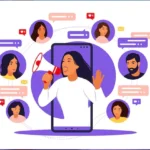An IBM study reveals that around 29% of marketing companies and 23% of marketing workers use AI’s natural language processing application to generate content. Rapid adaptation of AI in content writing has its own drawbacks. AI-generated content can backfire if not used wisely. The machine-generated algorithm-based content lacks emotion and creativity, failing to engage readers.
Does that mean one should avoid using AI to write content? No! In this era of digitization, where groundbreaking technologies like AI are being explored widely, not savoring its benefits isn’t a wise decision. Then, what is the solution to this problem? The solution is easy and applicable; humanization. Giving a human touch to your AI-generated content can enhance the content quality and engagement level. Let us learn how to humanize AI content.
Generative AI in Crafting Content
Generative AI is one of the most surprising and revolutionary extensions of artificial intelligence. It uses prompts at the outset to process content. These prompts can be in the form of text, image, design, video, or any other processable input. Gen-AI models use neural networks to identify patterns from the prompts, which are later processed using AI algorithms to generate new content. However, before knowing how to humanize AI content, let us learn about its pros and cons.
Generative AI has various potential benefits, as mentioned below-
- Automating manual writing
- Improving responses to queries
- Simplifying the content-creating process
- Transforming complex information into a rational narrative
Drawbacks of AI-Generated Content
Apart from its extensive benefits, AI-generated content has several drawbacks-
- Plagiarism Issues: As AI draws data from multiple sources to generate new content, the risk of plagiarism persists. One can be sued for plagiarism if the AI-generated content is too close to the original source.
- Devaluing: The Google search engine is soon going to evaluate content on the parameters of experience, expertise, authoritativeness, and trustworthiness or E-E-A-T. AI-powered content may not stand out to these parameters, leading to devaluation.
- Inconsistent Quality: The quality of AI-crafted content varies, depending on the information available on topics. This affects consistency in its outputs of all subject matters.
- Needs Human Intervention: AI-generated content requires human intervention due to its lack of awareness. One should not use AI content without proofreading or editing to avoid inaccurate and offensive content delivery. Relying solely on AI content can be disastrous for any business or any individual.
The drawbacks and benefits of AI-powered content have pointed out the need for humanizing it. Let us now learn the ways we can humanize AI content.
How to Humanize AI Content?
Amidst the debate about AI’s potential to replace humans in the near future, another loophole in the technology has tapered that possibility. AI-generated content needs a human touch to become more appealing and engaging to readers. Without human interference, the direct use of AI content can lead to inverse consequences, such as losing readers, decline in sales, poor conversion rate, and more.
Now, the question surfaces- how to humanize AI content? So, here are five effective ways in which one can humanize AI-generated content-
Scraping Jargon and Complexities from the Content
AI content usually contains a lot of jargon, complex words, and complex sentences, intending to make it sound intelligent. Whereas the real scenario is way different from AI’s perceptions. Smart humans prefer to communicate in simple ways and read content that resonates well. AI-created content lacks that and should be corrected, either manually or using ChatGPT prompts. Well-explained prompts specifying your requirements can re-generate the desired content, eliminating robotic language.
Incorporating Emotion and Stories
Gen-AI content is generally factual and lacks emotional connection. Integrating relevant real-life stories and experiences can give that desired human touch to AI-generated writing. A storytelling approach to writing always helps to touch the chords of readers’ hearts. This can be done both manually or using prompts.
Enhancing Fluency
AI content may sound mechanical if it’s over-engineered. Good writings always have a natural flow that engages readers spontaneously. In order to make the AI content slide naturally, paragraphs should be written in a meaningful and cohesive manner. This way, the writing will sound more human compared to the first content generated by AI.
Personalization
AI content sounds similar to one another, making it less engaging for readers. Giving a personal touch can transform the entire content. Your writing should have your unique perspective to make it more attractive to readers, not the same old stiff pattern of AI content.
Fixing Robotic Patterns
Losing traffic to your website with AI-generated content? Even expert writers can go wrong while using AI content for marketing purposes. Spotting such loopholes in your content and replacing them can not only change the look but also the engagement of the content. A clear ChatGPT prompt requesting the elimination of robotic patterns from the content can save writers from working tirelessly to edit manually.
The purpose of good writing is to connect with the target readers. If content fails to connect, it is likely to lose readers’ engagement. Acing AI writing requires smart use of the technology to eliminate the red flags put forward by the technology itself. With effective ChatGPT prompts, the issues of complex and stiff AI patterns can be edited. There is a fine line between a great and a good content. Humanization is the fine line that turns good content into a great one. These five ways can humanize the AI content, helping it stand out from the crowd.










